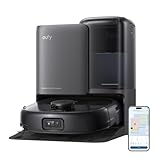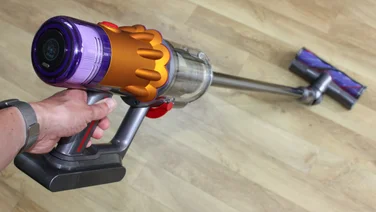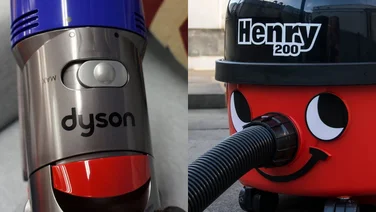To help us provide you with free impartial advice, we may earn a commission if you buy through links on our site. Learn more
- Our experts have tested over 100 robot, upright and cordless vacuum cleaners, putting each through a series of real-world tests to guarantee a fair judgement
- The robot vacuum cleaners on this page are assessed against several key metrics, including cleaning performance, battery life and navigational ability
- Our current favourite robot vacuum cleaner is the Eufy Omni E25. It’s both an effective vacuum and mop, and its reasonable price earns it an easy recommendation
- If you’re on a tight budget, we recommend the Eufy E20. It’s an unusual robot in that it combines a stick vacuum capability with a robot vacuum but for £250 it’s unbeatable
- Read on to find out which other robot vacuums are worth your time, no matter your budget

The best robot vacuum cleaner we’ve tested is the Eufy Omni E25. Fully featured and reasonably priced, Omni E25 performed incredibly well in our cleaning tests and proved pleasingly simple to set up. It’s perfect for anyone who wants a no-fuss, top-of-the-line robot vacuum that can mop nearly as well as it vacuums.
Our team of expert testers has reviewed over 100 vacuums, including cordless models, handheld vacuums and even our favourite vacuums for pet hair. On this page, we’ve picked out our favourite fully tested robots. Below, you can find a quick list of our top picks with prices and buying links. Underneath, you’ll find our short reviews of the robot vacuums themselves, with links to our full-length reviews at the end if you’re interested to read more.
We’ve also put together a buyer’s guide at the bottom of this page with all the most important information. So if this is your first time buying a robot vacuum and you need to know what to look out for, we’ve got you covered.
Best robot vacuums: At a glance
- Eufy Omni E25: Best overall | Check price at Amazon
- Eufy E20: Best value | Check price at Argos
- Dyson 360 Vis Nav: Best for cleaning power | Check price at Argos
How we test robot vacuum cleaners
We test each robot vacuum cleaner by installing it in a typical domestic setting. The charging station is always placed in the same location, and the robot is given the same basic floorplan of 58m² to clean, so we can see how elements such as navigation and speed compare between every robot we review. It’s a demanding floorplan that challenges even the smartest robot, with plenty of corners, tight spots, low furniture, surface changes and cable nests.
During our testing, each robot is connected to Wi-Fi and controlled through the supplied app, where available. We test all the features and functions, including self-emptying and navigation to a second floor, to ensure robots can handle switching between multiple maps. If a robot comes with a mop attachment, we also test this by running a basic clean cycle across our floor.

When it comes to analysing a robot’s cleaning capabilities, we test each robot using 50g of rice and flour and 5g of pet hair. We send the robot to perform a spot clean of each spill on both carpet and hard floor, and measure the amount collected each time. This indicates how effective each robot is at gathering these problematic materials, and allows us to compare the results with every robot vacuum cleaner we’ve ever tested.
The best robot vacuum cleaners from our testing
1. Eufy Omni E25: Best overall
Price when reviewed: £849 | Check price at Amazon

- Cleans carpets and hard floor thoroughly
- Speedy cleaning and self emptying
- Good value, great app
- Base station is bulky
Reviewed by Alun Taylor
The Eufy Omni E25 is – hands down – the best robot cleaner we’ve ever tested. Not only is it an incredibly effective and easy-to-use hands-off carpet cleaner – it cleaned 90% of flour, rice and dog hair on hard floor and carpet – but our tests showed it to be a brilliant mopper of hard floors as well.
It will also empty, clean and charge itself after every use, so all you need to do is replace the water and empty the bin in its base station from time to time. Its cameras and LiDAR system help it avoid obstacles and cables. And it will even spot stubborn stains and go back over them until they’ve been thoroughly cleaned.
Coupled with one of the best apps we’ve come across and speedy cleaning – in our testing it vacuumed carpet at a rate of 1m 9secs per square metre – plus a very reasonable price, and you have the complete robot vacuum. The base station is quite large, but that is the only negative thing we can think to say about it.
Read our full Eufy Omni E25 (2025) review
Key specs – Size (WDH): Robot, 326 x 348 x 112mm / Base station, 370 x 462 x 437mm; Battery life: 216 minutes (vacuum only); 125 minutes (vacuum and mop); Navigation type: LiDAR/camera; Mopping: Yes; Self emptying: Yes; Bin capacity: 3 litres
2. Eufy E20: Best value robot vacuum (and it’s a cordless stick as well)
Price when reviewed: £250 | Check price at Argos

- A cordless stick and robot vacuum in one
- Sold navigation and app control
- Competent cleaning
- Not the best in any category
- Lacks anti-tangle
Reviewed by Andy Shaw
Robot vacuums are good, but they can’t clean ALL the surfaces in your house – the tops of cabinets, the cobwebs from the ceilings or the boot of the car. But wait, the Eufy E20 can, because it combines both robot vacuum and cordless stick in one device.
Like all good robot vacuums, it comes with LiDAR navigation and a self-emptying charging station so you don’t need to empty it as frequently as you might do otherwise. It performed well in our tests, making its way around obstacles effectively and cleaned speedily, too.
When the time comes to use the cordless stick to clean the areas the robot can’t reach, you just pull out the handheld unit, attach the extension wand and motorised head to it, then operate as you would any other normal vacuum. It’s a great performer in this mode, cleaning up 94% of all our test spills on both carpet and hard floor.
Perhaps the most impressive thing about the E20, though, is how reasonably priced it is: you’re only paying £250 for both robot and stick vacuum combined, and considering how versatile and effective it is (and how expensive other robot vacuums are) that makes it incredibly good value for money.
Read our full Eufy E20 (2025) review
Key specs – Size (WDH): Robot, 350 x 350 x 119mm / Base station, 250 x 150 x 387mm; Battery life: 180 minutes (robot) / 49 minutes (stick vacuum, eco mode); Navigation type: LiDAR/camera; Mopping: No; Self emptying: Yes; Bin capacity: 3 litres
3. Dyson 360 Vis Nav: Best robot vacuum for cleaning power
Price when reviewed: £1,000 | Check price at Currys | Amazon

- Most powerful robot we’ve tested
- Excellent edge cleaner
- Effective mapping
- No self-emptying function
- No mop
- Very expensive
Reviewed by Andy Shaw
When it comes to suction power, nothing beats the Dyson 360 Vis Nav, making it, in our opinion, the most powerful robot you can buy. With Dyson’s powerful Hyperdymium motors, there isn’t much loose dirt that can stay on the floor when this beast passes over it.
We think other unique features make the 360 Vis Nav worth considering, too. Although most robots can handle most types of flooring, the soft roller on this model means it was particularly effective on hard floors in our tests, while its bristles mean it’s equally good on carpets.
We found it to be more effective at cleaning along edges than most, too. Instead of wispy, spinning brushes that flick dirt into the path of its brush, the 360 Vis Nav has an arm that extends out of the side, to suck it directly under the vacuum. Despite its obvious strengths, however, the Dyson is very expensive and, for that money, we’d also expect it to have self-emptying and effective mopping. Alas, it has neither.
Read our full Dyson 360 Vis Nav (2023) review
Key specs – Size (WDH): 330 x 345 x 97mm; Weight: 4.5kg; Battery life: 65mins; Charge time: 2.5hrs; Mopping: No; Self emptying: No; Navigation type: Laser/camera; Bin capacity: 0.57l
We also tested…

Not every robot vacuum we test makes it onto our list of favourites, and there’s a variety of reasons why that might be the case. Sometimes, they’re just not good enough but that’s not always why a product doesn’t make the grade.
Sometimes it’s because it’s become harder to buy, and sometimes it will have been replaced by newer, more capable hardware. But that’s not to say they’re not worth considering, especially if you find them at a tempting price. We’ve listed the robots that applies to down below, with links to the original reviews, just in case you find them at a big discount.
- iRobot Roomba Combo 10 Max (vacuum and mop)
Our rating: 4/5 | Price when tested: £1,399 | Not currently available - Shark Matrix Plus 2-in-1 (RV2620WAUK) (vacuum and mop)
Our rating: 3/5 | Price when tested: £500 | Check price at Amazon - Lefant M210P (vacuum only)
Our rating: 3/5 | Price when tested: £240 | Check price at Amazon - Eufy Clean X10 Pro Omni (vacuum and mop)
Our rating: 4/5 | Price when tested: £799 | Check price at Amazon - iRobot Roomba J9+ (vacuum and mop)
Our rating: 4/5 Recommended | Price when tested: £1,249 | Check price at Amazon - EZViz RS2 (vacuum and mop)
Our rating: 4/5 Recommended | Price when tested: £900 | Check price at Ezviz
How to choose the best robot vacuum cleaner for you
What specifications and features are the most important?
Object avoidance: A relative recent innovation in the robot vacuum space is object avoidance, but we think it’s an essential feature. Robot vacuums with this feature use sensors and cameras at the front of the robot to detect and avoid objects like socks cables and pet mess, skirting around them so you don’t have to worry about keeping a completely clear floor
Self-emptying: Once the sole preserve of expensive, premium robot vacuums, most modern robot vacuums, even relatively cheap models, can now automatically empty themselves into a larger base station bin and keep cleaning. They can be quite bulky, though, so you’ll need to make sure you have the space before buying.
Mopping: Robot vacuums with mop attachments used to be pretty useless but they’re now becoming more proficient with spinning rollers or rotating mop pads the most effective means of keeping your floors clean. The best robot mops also clean and dry themselves when they get back to base, keeping nasty niffs at bay.
Height: One thing robot vacuums are great at is cleaning below low-lying furniture, but some are considerably taller than others. It’s well worth checking out the dimensions before you buy to make sure it will fit if you’re planning on using it to clean under things.
Which robot vacuums give the best cleaning performance?
Although most robot vacuums look the same from the outside, they deliver vastly different levels of cleaning performance. And this is affected by a number of different factors.
Brushes and edges: Our favourite robot vacuums, such as the Dyson Vis Nav, have brushes that span the full width of the unit, allowing them to clean right along the edges of your room and into the corners. Unfortunately, these aren’t particularly common and most stick with the popular disc shape, with the main brush situated between the wheels and a couple of less effective spinning brushes at the edges to drag dust into the mouth of the vacuum.
Suction power: Next, you need to consider suction power. Typically expressed in pascals (Pa), this is a measurement of how powerful the motor is inside a robot vacuum. Once, we’d be happy to see a figure of 2,000 or above for an effective clean; these days, robot vacuums are far more powerful, with some delivering suction of up to 20,000Pa.
Mopping: If you want your robot to be able to clean hard flooring as well as carpets, you want to look for models with spinning pads or rotating mop rollers as these provide the most effective cleaning ability. Another specification to look out for here is the amount of pressure the robot is able to apply to the pad while it is cleaning. The more pressure, the more effective the clean.
How well do they deal with household obstacles?
All robot vacuums employ bumpers and sensors to help them navigate their way around your home and prevent them from coming to grief by falling down the stairs. But some are more efficient at finding their way around than others.
Predetermined cleaning patterns: The cheaper versions run to a random cleaning pattern and bump around your rooms blindly, cleaning as they go. This works up to a point but it can take a while for these types of vacuum to finish cleaning a room and, though they do their best, they often miss spots here and there.
LiDAR sensors: The most effective cleaning robots employ spinning LiDAR (light detection and ranging) sensors to map out their surroundings first before tackling each room. This means they can work out the most efficient route before even getting started, can navigate in the dark and don’t need to cover the same spot twice. Even then, advanced sensors can only go so far. A big problem with robot vacuums is that, no matter how good they are at mapping out their surroundings, they often get beached on low-lying furniture.
Object avoidance: This is where object avoidance comes in. With a robot vacuum you want to be able to leave it to its own devices to get on with cleaning without you having to worry about a stray sock getting stuck in the brush bar. Robots with object avoidance have front-facing sensors that can detect such obstacles and will navigate around them without getting stuck or causing further mess.
No-go zones: Another way to help your robot not get stuck is to set up no-go zones using the companion app – a feature that most offer, but some still don’t. This usually works by drawing boxes around the areas of the map of your floor that you don’t want it to clean in. Either way, you want to avoid a robot vacuum that doesn’t have this feature as there will always be an area of your home it regularly has problems with.









